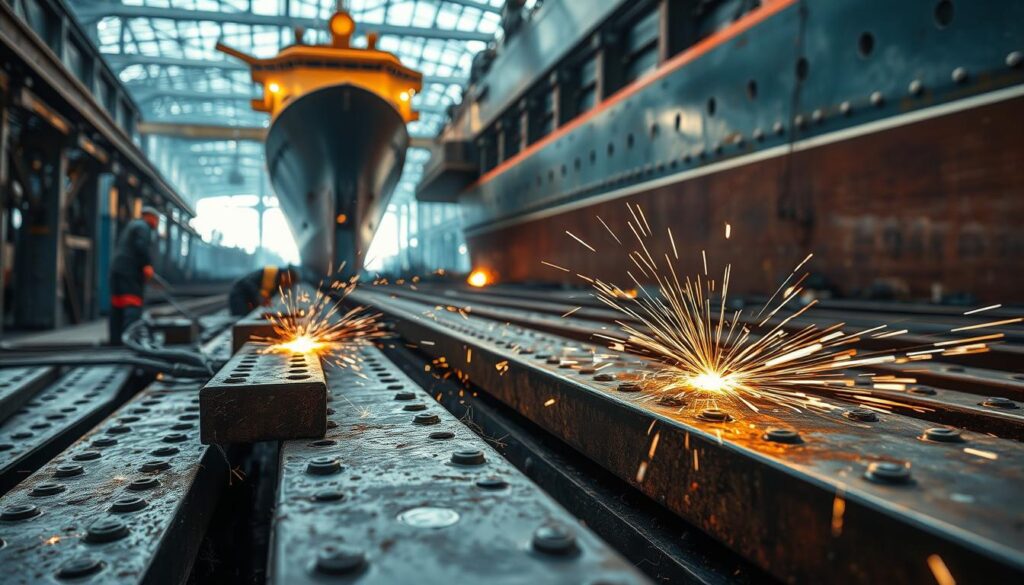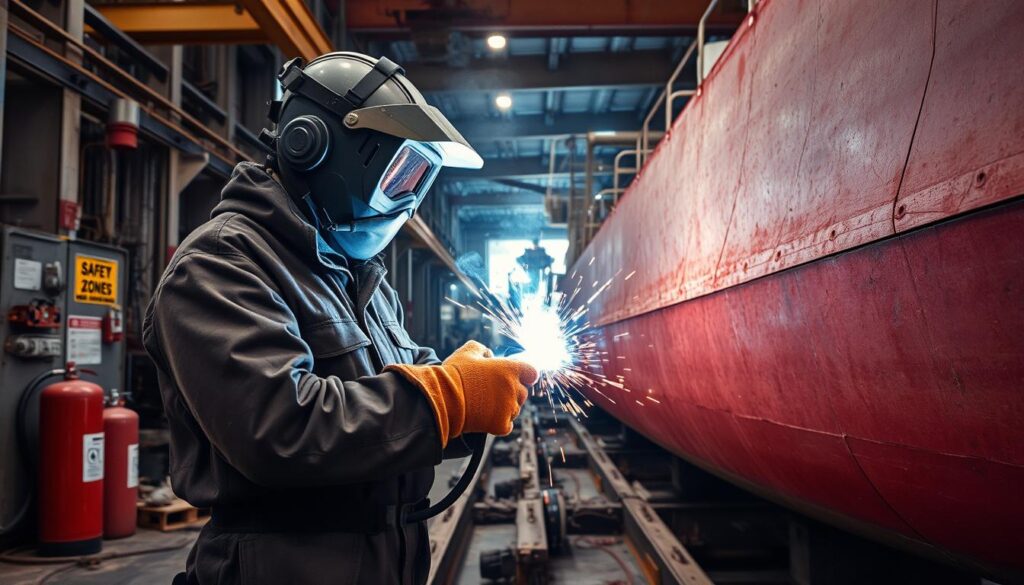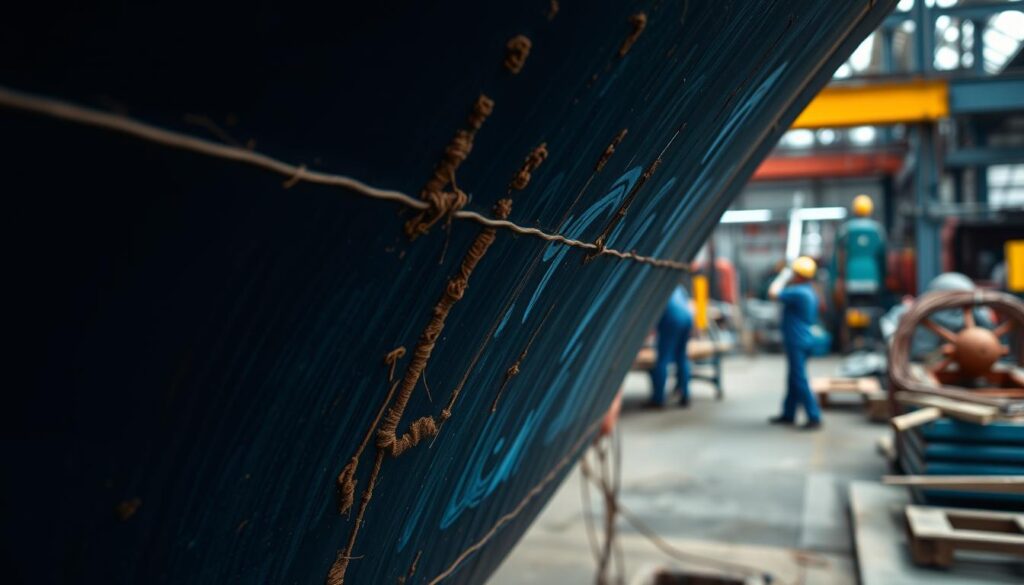-
 Call Now ! +86-13912367818
Call Now ! +86-13912367818 -
 Email Now info@wxhlhg.com
Email Now info@wxhlhg.com


Explore the critical role of welding in assembling robust ship construction parts for the maritime industry.
Welding is central to shipbuilding. It faces many challenges that need resilience, precision, and new ideas. Welding is not just a small part of shipbuilding; it plays a key role. It helps to build ships that are strong and last long. With welding, ships are made to withstand the sea's harsh conditions. They also meet all the needed standards and what clients want in terms of strength and lasting value1. Welding brings together productivity, safety, and profit. It significantly changes the shipbuilding sector2.

● Welding provides the cornerstone of durability and safety for ship construction.
● Advanced welding processes, including submerged arc and orbital TIG welding, are essential in the industry's progression13.
● The choice of welding technology impacts everything from production speed to in-service performance and longevity23.
● Adherence to international standards and regular inspections underscore the non-negotiable pursuit of quality and safety2.
● Emerging technologies, such as mechanized welding equipment, are honing precision and efficiency while minimizing risks2.
● High-strength steel alloys require specialized welders like the Power Wave AC/DC 1000 to handle their unique demands1.
Exploring modern shipbuilding, we see a big change from old riveting to new welding methods. This change marks a major leap in how we build and design ships
Welding has taken the lead over riveting in shipbuilding, improving both efficiency and quality. In the past, riveting was key for joining metals but fell short on durability and required a lot of labor. Now, welding, with techniques like MIG and TIG, has started a new era. It brings cost savings and stronger welds, cutting down on build time and making ships more robust45.
Welding methods today greatly strengthen ships. They make joints and seams stronger and better at handling stress and wear. Using advanced welding, like electron beam and laser, helps make seamless structures that stand up to sea conditions5. Also, strict quality checks and standards in welding ensure ships are reliable and safe4.
Automated welding in shipbuilding boosts efficiency and helps control costs. By using robotics and precise welding methods, ship assembly time is significantly reduced. This improves cost efficiency. Lean manufacturing in welding also lowers waste and uses resources better, cutting costs and increasing productivity.
Building ships requires the utmost precision and quality. Some welding methods excel by being versatile and effective. They ensure that boats are safe and sturdy.
Metal Inert Gas (MIG) welding is fast and easy. It's great for quickly putting together big metal parts in shipbuilding6. It's used when tasks need to be done swiftly, like making a ship's steel structure7. Tungsten Inert Gas (TIG) welding, on the other hand, is known for high-quality welds. It offers great control, perfect for making strong, precise parts with materials like stainless steel and aluminum6.
For perfect welds in complex pipelines and tight spots, orbital welding is the go-to. Its accuracy is key for top-notch ship parts, ensuring they work smoothly at sea7.
Submerged Arc Welding (SAW) is perfect for thick steel sheets in ships’ structures. It makes more work get done faster and improves weld quality. This contributes a lot to a ship's strength6. SAW is also cost-effective for sheets over 6 mm thick. It helps keep costs down without losing out on strength7.
Knowing what each welding technique does helps pick the right one for shipbuilding. This ensures the best use of resources and makes the ships we build last longer and perform better.
| Welding Technique | Key Applications in Shipbuilding | Advantages |
| MIG Welding | Primary steel frameworks, fast-paced assembly lines | High productivity, suitable for thick materials |
| TIG Welding | Precision components like propellers | Superior quality welds, excellent for non-ferrous metals |
| Submerged Arc Welding | Structural integrity of hulls | Deep penetration, minimal welding defects |
In modern shipbuilding, knowing about ship construction parts and following strict welding criteria is key. A ship is made of 50 to 200 sections. Each must be put together and welded with care8.
Using advanced welding methods is critical. They must meet high stringent quality control standards. Submerged arc welding is widely used for its fast and efficient work9. It ensures all parts are welded well, keeping up with quality10.
From the ship's keel to its framing and plates, every part must be welded right. They face lots of stress at sea. Groups like Lloyds Register and the American Bureau of Shipping set the welding rules. They make sure ships are safe and strong10.
| Welding Technique | Application in Shipbuilding | Benefits |
| Submerged Arc Welding | Main hull sections | Efficient, high-quality joins |
| MIG/TIG Welding | Superstructures and smaller assembly components | Flexibility and precision for complex shapes |
| Plasma Welding | Advanced materials like aluminum alloys | High penetration with minimal distortion |
| Laser Beam Welding | Penetrative welds in thick sections | Precision and control in single-pass welding processes |
Building a ship involves assembling prefabricated parts. They're carefully welded together. Each part is put in place following a detailed schedule8. This plan includes all key tasks from start to finish, ensuring the project stays on track.
To sum up, mastering welding and quality control in shipbuilding is crucial. We keep improving our welding and quality checks. We're dedicated to making ships that are not just strong but also reliable. Every weld and part plays a big role in the ship's overall strength and function.

In shipbuilding, paying close attention to safety and quality is key. This ensures we make ships that are strong, can be trusted, and meet the high demands of the ocean. It's vital to stick to strict safety rules, follow global standards, and do thorough checks.
Keeping welders safe is a big deal in building ships. It’s important to make sure they all have the right safety gear. They must also get full training on how to stay safe. Doing this not only keeps them healthy but also improves the quality of their welding.
This makes for a safer place to work and keeps the quality of ships high. Giving welders helmets, gloves, and eye protection is crucial. Regular safety meetings are also a must.
Following global welding rules is a must to make sure ships last a long time. These rules help shipbuilders pick the right stuff, like gas for welding and how to hold the welding tool11. Sticking to these rules means our ships are safe and meet worldwide use standards.
Checking the quality of shipbuilding is very important. Using special tests like ultrasonic and X-ray testing, we can examine welds closely11. These tests help find any welding mistakes early. This way, we can avoid problems once the ship is at sea.
Doing regular checks and knowing a lot about shipbuilding helps a lot. For example, using steel the right way12 makes sure every step of making a ship adds to its safety and usefulness.
| Key Focus Area | Technique/Standard | Impact on Shipbuilding |
| Material Usage | Steel and Advanced Cutting Machines12 | Ensures durability and precision in ship structures |
| Welding Process | Arc and MIG Welding12 | Provides strong structural connections |
| Inspection Techniques | Ultrasonic and Radiographic11 | Facilitates high standards of quality control |
| Ship Fabrication | Modular Construction12 | Enhances efficiency and control in building processes |
By really sticking to international welding rules and careful checking, the shipbuilding field keeps getting better. This ensures every sea vessel is as safe and high-quality as possible.
Advanced technologies are making shipbuilding better and more efficient. Automated welding systems are a big part of this change. They improve how welding is done, ensuring work is precise and that mistakes are few.
Automated systems make welding work faster and better. They help make more ships in less time, saving money13. Although they cost a lot at first, they pay off by boosting work and cutting down on paying many workers13. Automated welding is key to keeping the shipbuilding industry growing strong.
New welding systems like hybrid laser arc welding are becoming important. They prevent problems caused by using thinner metal plates14. Also, techniques like explosion welding are making stronger ships by joining different materials well14.
The shipbuilding world is always changing, needing new skills and learning. Soon, many welders will retire15, so we need to train the next wave of experts. These new welders must know both the old and new ways of welding. Some areas, like the East Coast, need special skills for building certain types of ships15.
Together, shipbuilders are working to mix new tech with skilled people. By doing this, the industry can face future challenges well and safely.
| Technology | Impact on Shipbuilding | Current Adoption |
| Automated Welding Systems | Increases productivity and reduces costs | Widely implemented across major shipyards |
| Hybrid Laser Arc Welding | Addresses thermal distortion challenges | Increasingly used in modern ship designs |
| Explosion Welding | Enables efficient multi-material assembly | Adopted for specialized applications |

Welding is crucial in making ships. It helps keep them strong and safe for a long time. Shipbuilding has grown from relying on skill alone to using science and art. This change has made ships better in many ways, like size and safety16. Welders have had to change their methods, too. This ensures that ships perform well in water and have all the needed features17.
The materials and methods used in shipbuilding must meet strict rules. These rules are about how strong and big parts of the ship should be16. Making spaces for crew members safe and comfortable also requires top-notch welding17. Planning how much a ship carries shows how detailed shipbuilding is. Welding brings all parts of a ship together, from bottom to top16.
The shipbuilding industry looks forward to a bright future. New technologies are making welding and building ships better. But one thing always stays the same. That's the dedication to quality. Mekalite works hard to improve welding for the ship industry. This helps in making ships that last long and are reliable. It shows we're ready to face new challenges with our partners' trust.
Welding is key in shipbuilding. It keeps ships strong and lasts long. It's used to connect hull plates and important ship parts. There are strict rules for welding to make sure ships can handle the sea.
Changing from riveting to welding changed shipbuilding a lot. Ships are now stronger and built faster. Welding makes ships better in many ways, like saving fuel.
Shipbuilding mainly uses MIG, TIG, and SAW welding. Each way is used for different things. They help make shipbuilding faster and more precise.
Welding criteria are very detailed for building ship parts. They make sure every part from the bottom to the top and sides, can last in the sea. Good technology and careful checking are crucial for the ship to be safe and strong.
For safety and quality, there are strict welding rules and safety gear. Training for welders and careful checks are important. Equipment is checked often, and welding is examined closely.
New tech like robots in welding helps make things better and more uniform while cutting down mistakes. New materials and welding ways are also coming up. They meet the new needs of shipbuilding.
Welding is crucial in making marine vessels because it makes them strong and efficient. It shows the industry's focus on quality and new ideas. This helps improve how ships are made.
Leave a Reply